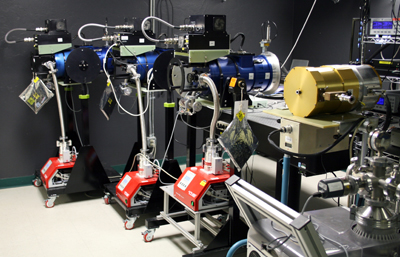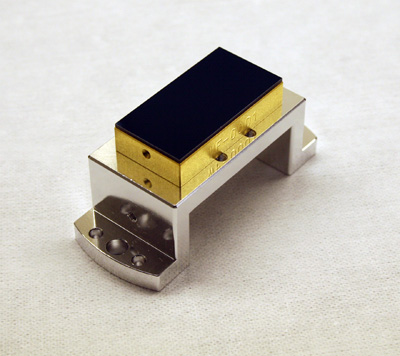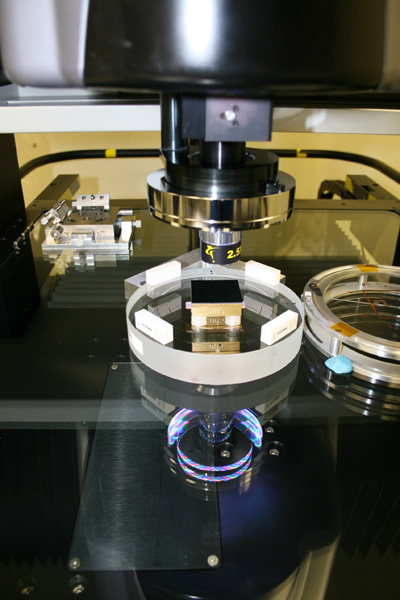Spotlight
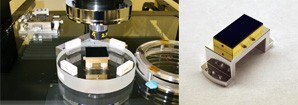
Steward's Imaging Technology Laboratory Delivers More Than 100 CCDs For The LSST Telescope
The University of Arizona has completed delivery of over 100 science-grade 4kx4k Charge-Coupled Device (CCD) image sensors for the Large Synoptic Survey Telescope (LSST). This work was performed at the UA Imaging Technology Laboratory (ITL). The sensors are among the most demanding ever produced in terms of quantum efficiency, readout speed, and surface flatness. ITL had previously delivered a set of 4kx2k wavefront sensors which will also be used in the LSST focal plane. Both sensors were designed by Semiconductor Technology Associates, Inc. in California. The Imaging Technology Laboratory is directed by Dr. Michael Lesser and is a research group within the University's Steward Observatory. Financial support for LSST comes from the National Science Foundation (NSF) through Cooperative Agreement No. 1258333, the Department of Energy (DOE) Office of Science under Contract No. DE-AC02-76SF00515, and private funding raised by the LSST Corporation. The NSF-funded LSST Project Office for construction was established as an operating center under management of the Association of Universities for Research in Astronomy (AURA). The DOE-funded effort to build the LSST camera is managed by the SLAC National Accelerator Laboratory (SLAC).
Michael Lesser of ITL has graciously sent us three photos and explanations.
Photo 1 (Click to enlarge)
This photo shows the four liquid nitrogen cooled Dewars used for testing the science and wavefront sensors at ITL. During the project’s production phases, two sensors were often characterized each day, with the other dewars warming up or cooling down for subsequent testing.
Photo 2 (click to enlarge)
An LSST STA4400 2kx4k Curvature Wavefront CCD sensor on its aluminum test tower. The silicon CCD is mounted on a gold-plated silicon-aluminum alloy chosen for its excellent thermal characteristics. These sensors will be located in the “LSST corner rafts” and are used to provide feedback to the telescope’s active optics system.
Photo 3 (click to enlarge)
An LSST STA3800 4kxk4k CCD sensor undergoing final metrology inspection on a VIEW Summit 600 Coordinate Measuring Machine. The surface flatness of the sensors is typically less than 4 microns peak-to-valley. Every sensor produced underwent electro-optical and metrological characterization before delivery.
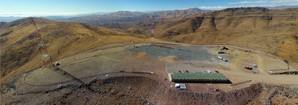
GMT has Shared a GMT-Site Drone Video
The GMTO has shared a 360 degree panorama taken by a drone. You can pan, zoom in and out, and start the video using the controls. The GMT is a partnership of (alphabetically) Arizona State University, Astronomy Australia Limited, Australian National University, Carnegie Observatories, The São Paulo Research Foundation – FAPESP, Harvard University, Korea Astronomy and Space Science Institute (KASI), the Smithsonian Institution, Texas A&M University, The Department of Astronomy of the University of Texas at Austin, The University of Arizona, and the University of Chicago. GMTO recently entered into an agreement with the NSF, NOAO, and the Thirty Meter Telescope International Observatory to seek federal funding and to give access to non-partner-institution astronomers.
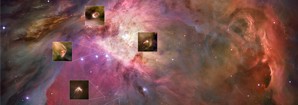
Protoplanetary Disks in Orion
A group of UA scientists ( Steward Professor Josh Eisner, Associate Astronomer Serena Kim, Steward Postdocs Nick Ballering and Min Fang, Steward Grad Student Ryan Boyden, and LPL Associate Professor Ilaria Pascucci) and their collaborators have used the ALMA telescope to image protoplanetary disks in the Orion star forming region. You can read the press release HERE. Josh Eisner has kindly written a couple of paragraphs that you can read below.
"Protoplanetary disks are the birth-sites of planets. A team of scientists led by the University of Arizona has imaged a cluster of protoplanetary disks in the Orion Nebula and discovered that they are smaller than those previously studied in closer, less-dense regions. These disks are similar in size to theoretical models for the protosolar nebula.
Given that our own solar system (and most systems in the Galaxy) likely formed in an Orion-like environment, this finding suggests that we may be observing typical planetary systems in the making.
The team's findings have been published in the Astrophysical Journal. The scientists used the largest telescope in the world, an interferometric array of radio telescopes in Chile called ALMA, to observe about 110 protoplanetary disks in the Orion Nebula in the deepest survey of the region yet. Based on the images, the team was able to calculate the masses and sizes of protoplanetary disks in the Orion Nebula. Their survey showed that Orion, with its massive stars and high stellar density, has disks that look significantly different than those in nearby, but less-dense regions. To confirm the effects of environment on the star and planet formation process, U of A scientists are pursuing grant funding and telescope time to study more regions of dense, high-mass star formation."
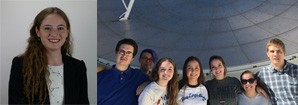
UA Undergrad Attacks Problem of Massive Star Formation in Molecular Clouds
Recent UA graduate Jenny Calahan (BS in Astronomy and Physics 2018), in collaboration with faculty Member Dr Yancy Shirly, has used Arizona Radio Observatory data to identify the possible birth places of stars weighing more than 8 Solar Masses. As well as Calahan (who is about to start graduate school at U Michigan) and Professor Shirley, Stewardites include Dr Brian Svoboda (PhD 2018, now a Jansky Fellow) , Elizabeth Ivanov, Jonathan Schmid, Anna Pulley, Jennifer Lautenbach, Nicole Zawadzki, Christopher Bullivant, Claire Cook, Laurin Gray, Andrew Henrici, Massimo Pascale, Carter Bosse, Quadry Chance, Sarah Choi, Marina Dunn, Ramon Jaime-Frias, Ian Kearsley, Joseph Kelledy, Collin Lewin, Qasim Mahmood, Scott McKinley, Adriana Mitchell, and Daniel Robinson. You can read the press release HERE. and a preprint of the journal paper HERE.
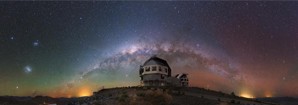
UA Astronomers Use New Data to Weigh the Milky Way
Steward Grad Student Ekta Patel and Steward Assistant Professor Gurtina Besla are the lead authors of a study to use the best-available observational data and physically conserved quantities to place robust limits on the mass of the Milky Way. Ekta provides the following text:
"Calculating the mass of our galaxy precisely is important for our understanding of galaxy physics, but it is difficult to do since we live inside of the Milky Way. The current widely-accepted theory on the growth of structures in our universe is the cold dark matter theory. This theory predicts that Milky Way mass galaxies should host around 100-200 satellite galaxies, or galaxies that orbit other galaxies. Currently, we know of about 50 satellite galaxies orbiting our own, so one reason a precise mass estimate is useful is to test how well this theory matches our observations in the context of the satellite galaxy population.
Many values of the Milky Way's mass, including some 30-year-old results from Steward astronomers, have been published over the last few decades using different methods. In this work, we present a method that appears to be robust when we use the information available to us and we hope that it will be a way to move forward as the observational data sets continue to grow and as numerical simulations of the universe improve. This method focuses on using the orbital angular momentum of satellite galaxies rather than their position and velocity to construct a mass estimate for the Milky Way. The benefit of using angular momentum is that it is conserved over time, unlike position and velocity. This means that no matter where a satellite galaxy might be in its orbit around its host galaxy (i.e. closest approach or farthest distance), the method still proves to be reliable. The second benefit of our method is that we use the properties of eight or nine Milky Way satellite galaxies simultaneously, which helps in yielding a more precise estimate. As the properties of additional Milky Way satellites are measured, we will be able to revise our current Milky Way mass estimate, which is about 960 billion times the mass of the Sun."
The UA press release can be found HERE.
The cover photo had to be trimmed to fit. To see Yuri Beletsky's full-size photo of the Milky Way with two of its satellite galaxies (the two Magellanic Clouds), click here. To see many more of his photos, go HERE.
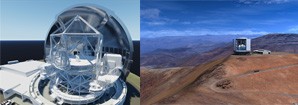
GMT, TMT, NOAO, and NSF Team Up on Next Generation of Telescopes
On Monday, May 21, 2018, it was announced that the GMT project, the Thirty Meter International Observatory, and NOAO and the NSF have joined forces. HERE is the press release from NOAO from which we quote a few paragraphs (the photos come from TMT and GMT websites):
"Our shared mission is to strengthen scientific leadership by the U.S. community-at-large through access to extremely large telescopes in the Northern and Southern Hemispheres. This two-hemisphere model will provide the U.S. science community with greater and more diverse research opportunities than can be achieved with a single telescope, and hence more opportunities for leadership.
Our immediate task is advocacy for frontier research programs led by U.S community scientists that can achieve exceptional advancements in humanity’s understanding of the cosmos.
Our audience is the U.S. research community as represented by the upcoming Decadal Survey of Astronomy and Astrophysics (an enterprise of the U.S. National Academies).
As an essential part of that immediate task, we will work with the U.S. research community to develop exemplar Key Science Programs (KSPs) within major research areas including the dark universe, first stars & first galaxies, exoplanet atmospheres, the surfaces of satellites and other small bodies throughout Solar System, and/or other topics to be proposed and prioritized by community-based working groups.
Key Science Programs are envisioned to be open collaborations that gather observers, theorists, and data scientists together to exploit significant investments of Thirty Meter Telescope (TMT) and Giant Magellan Telescope (GMT) observing time, from tens to hundreds of nights. Some of these collaborations are expected to be international in nature. If well-justified by KSP plans, we envisage that at least 25% of the observing time at each international observatory will be available for the U.S. community."
Pages

For Public
Public events include our Monday Night Lecture Series, world-reknowned Astronomy Camp and Mt Lemmon Sky Center.

For Students
A good place to start if you want to become an undergrad major or grad student, or need to find our schedule of classes.

For Scientists
Find telescopes and instruments, telescope time applications, staff and mountain contacts, and faculty and staff scientific interests.



